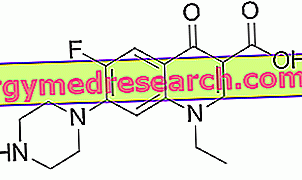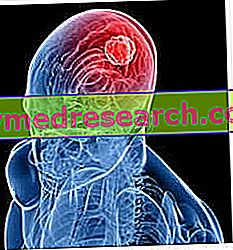Norfloxacin is an antibacterial belonging to the class of quinolones.
More precisely, norfloxacin is the progenitor of the fluoroquinolones and has bactericidal activity, ie it is able to kill bacterial cells.

Norfloxacin - Chemical Structure
It is marketed in pharmaceutical formulations suitable for oral and ocular administration.
Indications
For what it uses
The use of norfloxacin is indicated for the treatment of:
- Urinary tract infections, such as cystitis, pyelitis, cystopielites and pyelonephritis (oral administration);
- Superficial infections of the eye and ocular adnexa (ocular administration).
Warnings
Since norfloxacin administered orally can cause crystalluria, it is recommended to take abundant fluids throughout the treatment.
Norfloxacin may cause photosensitization reactions, therefore direct exposure to UV rays and sunlight is not recommended.
A great deal of caution should be used when administering norfloxacin in patients who suffer - or with a family history - of cardiovascular diseases.
If tendonitis occurs, treatment with norfloxacin should be stopped immediately and the doctor should be contacted immediately.
Administration of norfloxacin in patients lacking the enzyme glucose-6-phosphate dehydrogenase should be done with caution, as it may favor the onset of haemolytic anemia.
Norfloxacin can cause side effects that can affect the ability to drive and / or use machinery, so caution should be used.
Interactions
Concomitant administration of oral norfloxacin and tizanidine (a drug used to treat muscle spasticity in patients with multiple sclerosis) should be avoided.
Oral norfloxacin may reduce the effectiveness of oral contraceptives .
Antacids and products containing magnesium, iron, aluminum, zinc or calcium can decrease the plasma and urinary concentration of norfloxacin administered orally.
Before starting treatment with norfloxacin orally, you must inform your doctor if you are already taking any of the following medications:
- Nitrofurantoin, an antibiotic;
- Probenecid, a drug used to treat hyperuricemia and gout;
- Theophylline, used for the treatment of asthma;
- Caffeine ;
- Cyclosporine, an immunosuppressive drug;
- Warfarin, an oral anticoagulant;
- NSAIDs (non-steroidal anti-inflammatory drugs).
Also, you need to tell your doctor if you are already taking other drugs that can alter your heart rhythm. These include antiarrhythmics, tricyclic antidepressants, macrolides and some antipsychotics .
In any case - regardless of the route of administration chosen - it is however advisable to inform your doctor if you are taking, or have recently been taken, medicines of any kind, including non-prescription drugs and herbal and / or homeopathic products .
Finally, food, milk and its derivatives can interfere with the absorption of norfloxacin. Therefore, the drug should be taken on an empty stomach and between meals.
Side effects
Norfloxacin can cause various types of side effects, although not all patients experience them. The type of adverse effects and the intensity with which they occur depend on the sensitivity that each individual has towards the drug.
Below are the main side effects that may occur during treatment with norfloxacin administered orally.
Hepatobiliary disorders
Norfloxacin therapy may cause increased blood levels of liver enzymes, liver failure, hepatitis, cholestatic hepatitis, hepatic necrosis and jaundice.
Blood and lymphatic system disorders
Treatment with norfloxacin may cause:
- Leukopenia, ie the decrease in the number of leukocytes in the bloodstream;
- Neutropenia, ie decrease in the number of neutrophils in the bloodstream;
- Plateletopenia, ie decrease in the number of platelets in the blood;
- Eosinophilia, that is the increase in the number of eosinophils in the bloodstream;
- Reduced number of red blood cells;
- Hemolytic anemia (especially in patients with deficiency of the enzyme glucose-6-phosphate dehydrogenase);
- Increase in prothrombin time.
Allergic reactions
Norfloxacin can induce allergic reactions, even serious ones, in sensitive patients. These reactions can occur in the form of:
- Angioedema;
- Urticaria;
- petechiae;
- Bleeding bubbles;
- Papules associated with vasculitis;
- Interstitial nephritis;
- Anaphylaxis.
Pathologies of the central nervous system
Norfloxacin therapy may cause:
- Headache;
- dizziness;
- Drowsiness;
- Fatigue;
- Sensation of light head;
- paresthesia;
- polyneuropathy;
- Hypoaesthesia;
- Convulsions.
Psychiatric disorders
Treatment with norfloxacin can cause depression, mood changes, insomnia, nervousness, irritability, anxiety, euphoria, confusion and hallucinations.
Gastrointestinal disorders
Norfloxacin therapy can cause disorders such as:
- Abdominal pains and spasms;
- Nausea and vomit;
- Stomach ache;
- Diarrhea;
- Pancreatitis;
- Pseudomembranous colitis.
Musculoskeletal disorders
During treatment with norfloxacin, the following may occur:
- Tendinitis;
- tendovaginitis;
- Arthritis;
- Myalgia;
- arthralgia;
- Worsening of the symptoms of myasthenia gravis in patients suffering from it.
In addition, cases of inflammation of the Achilles tendon that caused the tendon to rupture have been reported.
Cardiovascular disorders
Norfloxacin therapy can cause palpitations and changes in the normal heart rhythm.
Kidney and urinary tract disorders
Treatment with norfloxacin may cause crystalluria, therefore, it is recommended to take plenty of fluids during treatment with the drug.
Skin and subcutaneous tissue disorders
During norfloxacin therapy skin reactions may occur, such as:
- Skin eruptions;
- Itch;
- Photosensitization reactions;
- Exfoliative dermatitis;
- Erythema multiforme;
- Lyell syndrome (or toxic epidermal necrolysis).
Other side effects
During treatment with norfloxacin may also occur:
- Changes in vision;
- Increased tearing;
- Tinnitus, ie an auditory disorder characterized by the perception of whistling, rustling, tinkling, buzzing, etc .;
- Anorexia;
- Increased serum bilirubin values;
- Increased serum urea and creatinine levels;
- Vaginal candidiasis.
Side effects of norfloxacin administered via the eye
Since the systemic absorption of the drug - when norfloxacin is administered via the eye - is very low, it is rare for the side effects described above to occur.
The main side effects that may occur following the administration of norfloxacin by the eye are burning or sharp eye pain.
More rarely, conjunctival swelling, redness of the eyes, photophobia and perception of a bitter taste in the mouth following the instillation of the eye drops may also occur.
Overdose
If you suspect you have taken an overdose of oral norfloxacin, you must contact your doctor immediately or go to the nearest hospital.
Your doctor may advise you to take calcium-containing drinks so that the systemic absorption of norfloxacin is blocked.
If too many drops of norfloxacin-based eye drops are administered - or if the eye drops are accidentally ingested - contact the doctor who will decide what to do.
Action mechanism
Norfloxacin, like all quinolones, inhibits DNA gyrase and topoisomerase IV.
DNA gyrase and topoisomerase IV are bacterial enzymes involved in the supercoiling, rewinding, cutting and welding processes of the two strands that make up the DNA of the drum itself.
With the inhibition of these two enzymes, the bacterial cell is no longer able to access the information contained in its genes. In doing so, all cellular processes (including replication) are interrupted and the beating dies.
Mode of Use - Posology
Norfloxacin is available for oral administration in the form of capsules and for ocular administration in the form of eye drops.
Norfloxacin - regardless of the route of administration - must be taken strictly following the instructions given by the doctor, both with regard to the amount of drug to be used, both as regards the duration of treatment.
Below are some indications on the doses of norfloxacin usually used in therapy.
Urinary infections
Oral norfloxacin is used to treat urinary tract infections.
The recommended drug dose is 400 mg twice a day. The duration of treatment varies according to the type of infection to be treated.
Infections of the eye and ocular adnexa
For the treatment of these infections, norfloxacin is used via the eye.
It is advised to instill 1-2 drops of eye drops in the eye, four times a day. In case of serious infections, the doctor may decide to increase the frequency of administration during the first day of therapy.
Pregnancy and breastfeeding
The use of norfloxacin - whether orally or ocular - by pregnant women or by breast-feeding mothers is not recommended due to the possible damage that the drug can cause to the fetus or baby.
Contraindications
The use of norfloxacin is contraindicated in the following cases:
- In patients with known hypersensitivity to norfloxacin itself;
- In patients with known hypersensitivity to other quinolones;
- In patients who have already suffered from tendinopathies following previous treatments with other quinolones;
- In children and adolescents under 18 years of age;
- In patients with a history of convulsive disorders;
- In patients already on tizanidine therapy;
- Pregnant;
- During breastfeeding.



